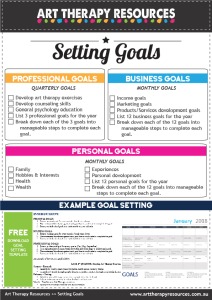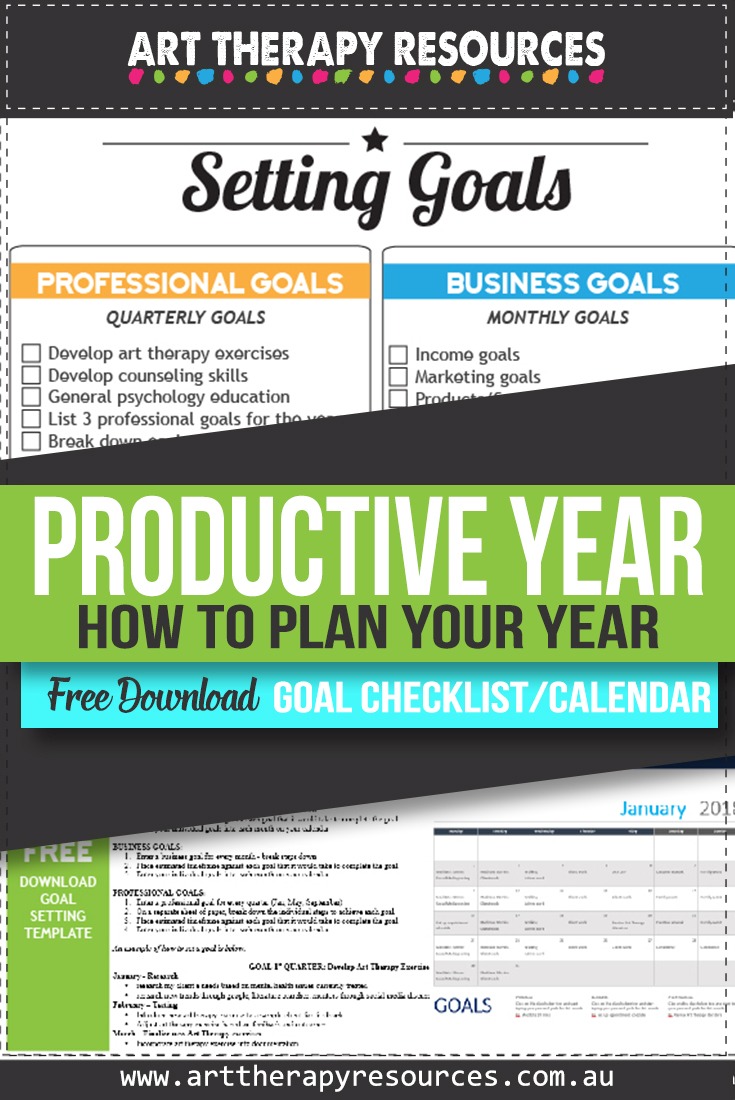THIS POST INCLUDES:
1. Why plan your year
2. Commit to a productive year
3. Choose your goals
4. Plan the year
5. Plan daily actions
6. Manage stress and obstacles
7. FREE Download Goals Checklist + Goal Setting Calendar Template.
WHY PLAN YOUR YEAR
Whether you’re an art therapist with a private practice or just looking to improve your productivity as a therapist working within the mental health field, planning your year can provide some significant benefits.
Planning your year provides a framework for what you want to achieve in your professional and personal life. When you plan your year, you begin to define the exact steps that it takes to make your goals achievable.
A general goal of ‘find more clients’ becomes more attainable when you break it down to planned tasks such as:
- January – contact referral network
- February – create email list for clients
- March – advertise on Facebook and Google …
When we plan for the year, we are planning for consistency as we make the commitment to allocate time for our tasks. Through this allocation of time, we can gain a more accurate picture of when our goals will be achieved and what resources we need to dedicate to each task.
COMMIT TO A PRODUCTIVE YEAR
The first stage to committing to a productive year is to set up a system that will enable you to:
- Set goals
- Plan your year
- Plan daily actions
Once these areas are defined and written down, you will have a blueprint for a productive year.
To help you stay committed you can employ a number of strategies to help foster a behavioural commitment:
- Reward yourself at various intervals of your goal setting. Your rewards could be financial or non-financial such as time spent on a favourite activity.
- Make yourself accountable. You could be accountable to a friend, colleague or online support group. There are a number of therapy practice Facebook groups that run challenges to implement goals
CHOOSE YOUR GOALS
BE SPECIFIC
You may want to increase client work and income but how does that statement translate into a tangible goal. Instead of making a general statement of increase client work, be more specific and state that you want to increase 1 client per day. This goal may be small but it’s also achievable and once you achieve your first goal, you have the impetus to set and achieve the next goal.
DEFINE THE TIMELINE FOR GOALS
If your goals entail tasks that you’ve previously you will have a benchmark for the length of time it takes to complete your goal. If your goal is a new one, you should estimate a timeline based on your current available time. It’s not helpful to set goals based on untested expectations and resources because this increases the likelihood of not meeting high expectations. As you set timelines for tasks you haven’t completed before, allocate time based on your availability and analyze the time you spend on the last once it is completed.
Use your calendar to create your timelines based on:
- Daily
- Weekly
- Monthly
- Yearly
Implement a review period to assess what goals need changing so that you keep moving forward.
PLAN THE YEAR
Planning the year helps you define the big picture of how you want your year to go.
Once you have planned your year, it may begin to look overwhelming. At this stage it’s important to prioritise your goals. If you’ve planned a year full of goals then ask yourself what is your top 3 goals out of your list. Once you have your top 3, ask yourself what ONE goal you would like to achieve if you only had one choice. The answer to this question should be your priority all throughout the year.
PLAN DAILY ACTIONS
Planning daily actions entail breaking down the tasks for your year plan into actionable steps. A year plan is great for a big picture view of the direction your therapy practice will go, however, it’s the daily actions that will help move you towards actually achieving your goals.
Similarly to the year plan, your daily plan should be prioritised. Set aside some time each day in the beginning and ask yourself what is the ONE task that I would like to achieve today. Now that you have that answer, review your schedule for the day and allocate some time to work on your goal. You do not have to set a large goal for the day. It is best to set a goal for the entire week and then allocate a small task to each day.
For example, your weekly goal may be to post 6 posts to social media. On a daily basis you can break your task down as follows:
MONDAY – find 5 posts to share from other websites or articles that relate to my skills
- What is anxiety
- Types of anxiety
- Benefits of mindfulness
TUESDAY – Brainstorm 5 more posts that I can share about my business:
- Opening hours and location of therapy practice
- Issues I can help clients with, eg anxiety among children, parents, etc
- How to book an appointment
WEDNESDAY – schedule posts sourced from Monday to post to social media over the next 5 days. Use a social media scheduler so the posts will be made automatically
THURSDAY – draft content for posts you will be posting about your business
FRIDAY – schedule posts created on Thursday to post to social media over the next 5 days. Use a social media scheduler so the posts will be made automatically
Each of the above tasks should only take 5-10 minutes per day. Thursday may be the longest day as you create your own written content and include an image if possible.
Eventually, as you gain confidence in doing a new task, your timeframes will reduce. With practice, the above steps scheduled over a week can be done on a Monday morning within 30 minutes. Posts with content about your business (eg. Tuesday’s post), can be reposted regularly as that information will always be relevant to your business and potential clients.
TIME BLOCKING
Time blocking is a simple concept where you schedule in your list of tasks into your calendar. You can choose to time block in a variety of ways:
- Set aside an entire day – useful for clearing a lot of smaller tasks or working on a large project
- Set aside half a day
- Set aside a morning or afternoon
- Set aside an hour at a time
- Set aside 30 minutes
- Set aside 5-10 minutes for mini tasks
The more time you block the more you can set aside time for larger projects. Unfortunately, most of us don’t have the time to block an entire day for one project, so the next best approach is to block off smaller increments of time where smaller tasks can be undertaken.
An important part of time blocking is that you block out all other tasks and distractions during that time period. Put your answering machine on, turn off phone notifications, and lock your door. This is the time you will dedicate to your task without any interruptions.
As you plan your time blocking keep in mind your energy levels. It may suit you to only time block for 30 minutes at a time and then take a break from that specific activity. Your time block should also be enough time to facilitate a feeling of flow where you can feel minimal pressure to complete a task in a shortened time frame. If you only have a small amount of time, then choose to do tasks that have less cognitive demands.
POMODORO TECHNIQUE
The Pomodoro Technique is a time management method that uses a timer to break down work into intervals. Work intervals are traditionally between 20-30 minutes long. After the work interval, you then have a 5 minute break and then resume another Pomodoro session. After 3-4 Pomodoro sessions, you then take a substantially longer break of say 30-60 minutes.
The Pomodoro technique is an excellent method of providing guidelines to complete work. If you are struggling with motivation and procrastination then setting yourself a defined time period of 30 minutes of work can help reduce resistance by relaying to your brain the confines of the struggle. You can tell yourself that you just have to complete your Pomodoro task and you can reward yourself with a break or another enjoyable activity.
MANAGE STRESS AND OBSTACLES
As the year progresses, our energy ebbs and flows and our commitment to achieving goals can be impacted by stress situations and events. Basically, life happens!
To help mitigate the negative impact life can have on goal setting and achievement, you can implement a number of strategies to help keep you motivated through periods when stress may be higher.
Even on our good days we can become distracted by perceived obstacles in our day.
Below are a number of useful tips to help stay on track with goals:
- Plan early so that you know what resources you need ahead of time
- Include easy wins on your task list for a confidence boost
- Take time for self-care (Self-care for the Art Therapist https://arttherapyresources.com.au/self-care-art-therapist)
- Know when to stop working on something and take a break
- Plan for procrastination – you could allow yourself extra time for time wasting or simply be aware of your procrastination techniques to enable you to avoid them
- Automate tasks where possible so that you are not wasting time on repetitive tasks
- Set up triggers for behavioural change – create a positive environment to trigger your brain to start work. Focus on stimulating some of the 5 senses for triggers
- Set up a productive work environment to facilitate a positive mindset
- Develop a mindfulness practice to get yourself in a focused mindset
- Expect the unexpected and know when to regroup your thoughts and energy
OTHER BLOG POSTS TO READ:
We’ve got an excellent backlog of previous posts to help you stay motivated and productive when planning your year.
The list below is divided into categories to help you work on specific areas in your practice:
TOOLS:
- 10 Useful Planning Tools for Your Business
- Review of Scrivener for Content Writing as a Therapist
- 10 Tools to Help Boost Your Productivity
- Planning Template for Your Art Therapy Practice
- Task Management Software For Art Therapy Planning
- Productivity Tools: Stay Focusd vs Rescue Time
- 10 Blogging Tools to Boost Your Content Writing Productivity
- 10 Useful Tips to Use Evernote for Blogging
PRACTICAL STEPS:
- How to Plan Your Marketing Strategies
- Six-Week Start-Up: A step-by-step program for starting your business, making money, and achieving your goals
- 10 Steps to Set Up Your Art Therapy Practice
MOTIVATION:
- Podcasts about Productivity and Getting Things Done (GTD)
- Smarter Faster Better: The Transformative Power of Real Productivity
- The Power of Habit: Why We Do What We Do in Life and Business
SELF-CARE
FREE DOWNLOAD: Goal Checklist + Calendar
SIGN UP below to download the FREE Setting Goals Checklist + Microsoft Word Goal Setting Template.
Files include: Checklist pdf + Goal Setting Calendar US Letter and A4 formats.

BUILD YOUR ART THERAPY REFERENCE MATERIALS:
Pin this image to your Pinterest board.

SHARE KNOWLEDGE & PASS IT ON:
If you’ve enjoyed this post, please share it on Facebook, Twitter, Pinterest. Thank you!
